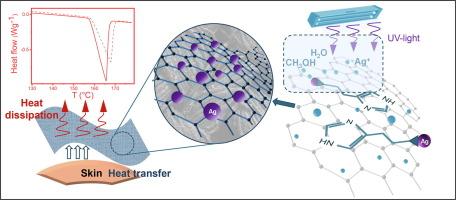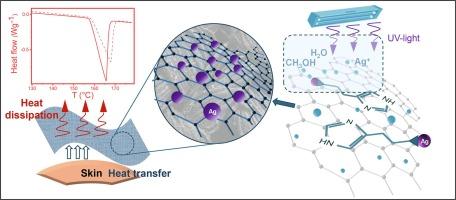基于原位合成银纳米粒子装饰的还原氧化石墨烯的新型棉织物导热涂层
IF 6.3
2区 材料科学
Q2 CHEMISTRY, PHYSICAL
引用次数: 0
摘要
应用导热材料作为纤维表面的涂层是一种创新的技术解决方案,可为不透红外的纺织品提供散热能力。本研究采用组氨酸(His)功能化的还原石墨烯氧化物(RGO)薄片和银纳米粒子(NPs)装饰,以可持续和可扩展的方式制造出一种混合纳米复合棉涂层,用于提高棉织物的导热性。在不使用化学还原剂的情况下,通过 H2O/CH3OH 溶液浸渍 AgNO3 前体,在紫外光照射下在 His-RGO 改性棉布的配位位点原位合成了数十纳米大小的 Ag NPs。通过化学、结构和形态分析以及热、电、透氧、表面润湿性和机械性能表征,对纳米复合改性织物的物理化学性能进行了全面研究。棉的导热性是通过差示扫描量热法(DSC)测量的,在此通过瞬态平面源(TPS)方法进行了验证,评估了 DSC 在测量纺织品导热性方面的有效性。结果表明,涂层的导热率是未经处理的棉花的两倍,同时还保持了透气性,增加了柔韧性,降低了湿润性。这种显著的提高可归因于纳米复合材料中 His-RGO 薄片之间形成的导电 Ag 纳米结构的协同效应,它与最先进的方法所实现的导热性相匹配,同时还具有更环保、可扩展和可持续的优势。报告中对所获得涂层的结构特性进行了描述,为其在个人热舒适管理的被动导电冷却纺织品中的应用开辟了有趣的前景。本文章由计算机程序翻译,如有差异,请以英文原文为准。


Novel thermally conductive coating for cotton fabrics based on reduced graphene oxide decorated with in situ synthesized silver nanoparticles
The application of thermally conductive materials as coating on fiber surfaces represents an innovative technology solution for conveying heat dissipation capability to IR-opaque textiles. In this work, a sustainable and scalable approach to manufacture a hybrid nanocomposite coating for cotton, formed by Reduced Graphene Oxide (RGO) sheets functionalized by histidine (His) and decorated by Ag nanoparticles (NPs), is reported for increasing thermal conductivity of cotton fabrics. Tens nm in size Ag NPs were synthesized, in situ, at the coordinating sites of the His-RGO modified cotton impregnated by H2O/CH3OH solutions of the AgNO3 precursor, under UV-light exposure, without using chemical reductants. The physical chemical properties of the nanocomposite modified fabrics were comprehensively investigated, integrating chemical, structural and morphological analysis, with characterizations of their thermal, electrical, oxygen permeability, surface wettability and mechanical properties. Thermal conductivity of cotton was measured by Differential Scanning calorimetry (DSC) technique, which was here validated by Transient Plane Source (TPS) method, assessing the effectiveness of DSC in measuring thermal conductivity of textiles. The resulting coating exhibits a thermal conductivity, which was twice as high as untreated cotton, maintaining its breathability, increasing its flexibility, while simultaneously reducing its wettability. This notable enhancement can be attributed to the synergistic effect of the conductive Ag nanostructures formed among the His-RGO sheets within the nanocomposite, and it matches the thermal conductivity achieved by current state-of-the-art methods, while offering additional advantages of being more eco-friendly, scalable, and sustainable. The reported characterization of the structural properties of the achieved coating opens the venue to interesting perspectives towards its application in passive conducting cooling textiles for personal thermal comfort management.
求助全文
通过发布文献求助,成功后即可免费获取论文全文。
去求助
来源期刊

Applied Surface Science
工程技术-材料科学:膜
CiteScore
12.50
自引率
7.50%
发文量
3393
审稿时长
67 days
期刊介绍:
Applied Surface Science covers topics contributing to a better understanding of surfaces, interfaces, nanostructures and their applications. The journal is concerned with scientific research on the atomic and molecular level of material properties determined with specific surface analytical techniques and/or computational methods, as well as the processing of such structures.
 求助内容:
求助内容: 应助结果提醒方式:
应助结果提醒方式:


